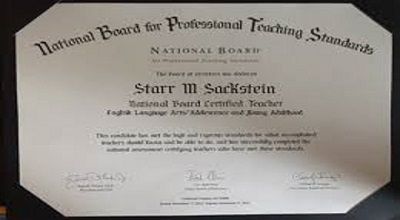National Board Teacher Certification
National Board Teacher Certification: To obtain National Board Teacher Certification (NBTC) in the United States as of 2024. You’ll need to follow a specific process outlined by the National Board for Professional Teaching Standards (NBPTS). The certification is available in 25 areas across 16 different disciplines and six student developmental levels, such as early childhood, middle childhood, early adolescence, and more.
Here’s an overview of the steps involved:
- Eligibility: You need to meet certain education, employment, and licensure requirements. This includes having a valid teaching license and a certain amount of teaching experience. There are also specific guidelines for overseas teachers, although the computer-based assessment is only administered in the U.S. and some U.S. territories.
- Selecting a Certificate Area: Choose from the 25 available certificate areas, based on your qualifications and the age range and content area you wish to certify in.
- Registration and Component Purchase: Create an account in the National Board Candidate Management System, register for the certification process, and purchase the components of the certification process. There’s a $75 registration fee each cycle year, and you must purchase at least one component to remain active.
- Completing Components: The certification process involves four components:
- Component 1: Content Knowledge (completed at a Pearson VUE testing center)
- Components 2-4: Portfolio submissions (electronically uploaded)
You have a five-year window to complete all components, with the expectation of completing purchased components within the assessment cycle.
- Scoring: Components are scored on a rubric scale, with Levels 4 and 3 representing accomplished teaching practice. To achieve certification, you need a minimum unweighted average score of 1.75 on Component 1 and Components 2-4, and a total weighted score of at least 110.
- Cost: The cost of certification involves a registration fee and fees for each component.
- Support and Resources: The NEA and other organizations offer support for teachers undergoing the certification process. This can include workshops, mentorship, and resources like the National Board’s Five Core Propositions micro-credentials.
- Maintenance of Certification (MOC): Once you are certified, you can extend your certificate for five years through the MOC process. This involves demonstrating continued professional growth aligned with the Five Core Propositions and National Board Standards for your certification area.
Note that the process is rigorous and designed to recognize highly effective and accomplished teaching practices. It’s recommended to thoroughly review all the guidelines and prepare adequately for each component of the certification process.
For more detailed information and to start your certification journey, you can visit the NBPTS website and the NEA’s page on National Board Certification.
Eligibility For Certification
The eligibility criteria for National Board Certification as of 2024 include several key requirements:
- Education: Candidates must hold a bachelor’s degree from an accredited institution. There are specific guidelines for international degrees and teachers educated outside the United States.
- Teaching License: You must possess a valid state teaching license. This license should be current and unencumbered (i.e., not suspended or revoked).
- Teaching Experience: Candidates typically need to have completed at least three years of teaching or school counseling experience before starting the certification process. This experience should be in a school setting.
- Employment: You must be employed in an educational role. This does not necessarily mean classroom teaching; various roles in education are eligible.
- Overseas Teachers: If you teach overseas, you are still eligible to apply for National Board Certification. However, please note that the computer-based assessment (Component 1) is only administered in the United States, some U.S. Territories, and Puerto Rico.
More here…
It’s important to note that these requirements are general guidelines and may have specific nuances or exceptions. For example, if you’re teaching in a non-traditional role or setting, or if you have unique qualifications or circumstances, it’s a good idea to review the detailed eligibility criteria and possibly consult with the National Board for Professional Teaching Standards for clarification.
For the most accurate and detailed information, you should visit the National Board for Professional Teaching Standards (NBPTS) website or refer to their specific documents like the ‘Guide to National Board Certification’ and ‘Eligibility Verification Forms’. These resources provide comprehensive details about all aspects of eligibility and the certification process.
How to Apply for Teaching Certification?
To apply for teaching certification in the United States as of 2024, you’ll need to follow these general steps, although specific requirements may vary by state:
- Choose a Bachelor’s Degree and Teacher Preparation Program: Start with a bachelor’s degree that includes a teacher preparation program. If you’re targeting a specific grade level or subject area, choose your major accordingly. For example, an elementary education major is suitable for teaching kindergarten through fifth grade, while a secondary education candidate might major in a specific subject like History or Math.
- Complete a Student Teaching Experience: This practical component is crucial and typically lasts at least one semester. You’ll be mentored by an experienced teacher and gain hands-on experience in classroom management and lesson delivery.
- Pass State-Required Exams for Educators: Most states require passing exams such as the Praxis series, which includes tests on teaching principles, content knowledge, and specific subject areas. Some states have their own specific exams.
- Apply for Teacher Certification: Once you’ve met the educational and exam requirements, apply to your state’s department of education for a teaching certificate. This process usually involves submitting documentation such as your degree, passing exam scores, and a background check. The cost of certification and the duration of the certificate’s validity can vary by state.
- Alternative Certification Routes: If you already have a bachelor’s degree in another field, consider alternative certification programs. These programs are designed for career changers and often allow you to teach while completing your certification requirements. They can include residency programs, accelerated programs, and more.
- Continuous Professional Development: Once certified, teachers are expected to engage in ongoing professional development to stay current in their field. This may include workshops, courses, and sometimes graduate programs.
Final Words
The National Board Teacher Certification requirements can differ significantly from one state to another. It’s important to check the specific requirements for the state where you plan to teach. You can usually find this information on your state’s Department of Education website or through teacher preparation programs in your state.
For more detailed and state-specific information, you should visit the relevant state education department’s website or consult with educational institutions that offer teacher preparation programs.





